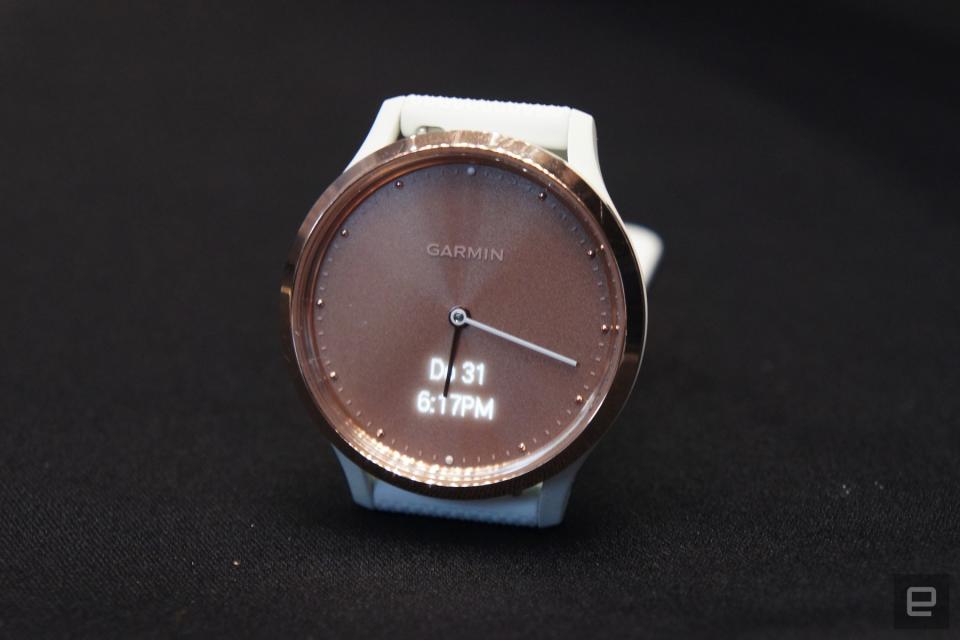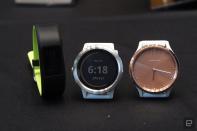Garmin Vivoactive 3 hands-on: More than just a running watch
The Vivoactive 3 has the potential to be as good a smartwatch as anything from more mainstream brands.
Garmin's image as a niche fitness brand catering for a group of hardcore athletes does the company a massive disservice. Because the newest generation of its Vivoactive and Vivomove watches have the potential to be some of the best on the market.
The flagship Vivoactive 3 comes with all of the features you'd expect from a high-end smartwatch, just with less of the cruft. It ticks the usual boxes, including GPS run tracking, an optical heart-rate sensor and basic notifications. But, in addition, you get the benefit of extreme battery life, guided workouts and mobile payments through NFC.
One of the biggest issues with swiping across a smartwatch display is how slow getting anywhere in a menu is. Samsung got around this problem by adding a rotating bezel to the Gear S2 and S3, while Apple kinda/sorta uses the digital crown for a similar purpose. Garmin's been a little smarter than both, and made one half of the Vivoactive's case sensitive to capacitive touch. So you can just swipe up and down to quickly get around the various menus and options in no time at all.

Then there's the fact that you can send canned responses to text messages from inside the watch, assuming you have a compatible smartphone. And you can access the small but perfectly formed ecosystem of apps that Garmin has formed around the watch. No, you can't order an Uber from your Vivoactive 3 -- not yet, at least -- but you can track the distance between you and your forthcoming ride. Which probably makes more sense for most folks who aren't in love with the idea of never using their phone at all.
And, unlike so many other devices that call themselves smartwatches, the Vivoactive 3 has class-leading battery life. In fact, in a world where so many timepieces last for less than two days on a charge, the fact that the Vivoactive 3 will last for seven days at a time is magical. Hell, you'll even get 13 hours of GPS usage in a single session, a huge improvement on the sort of figures you see on the Apple Watch and Android Wear.
We'll be able to confirm (or deny) how well it lives up to its own hype when we grab it in for review, but it's certainly promising. And if you'd like to buy one ahead of our verdict, you can do so when it launches for the sum of $300 with a stainless steel case, or $330 for a nicer-looking slate one.
Then there is Garmin's Vivomove HR, a hybrid that puts connected smartwatches from several other brands to shame. Much like its big sibling, the Vivomove comes with an optical heart-rate sensor, activity tracking and a five-day battery life. Lurking beneath the lower third of that analog face, however, is an OLED display that activates when you tap the number six on the dial. Then the hands will move to the 10:10 position and you'll be able to swipe through basic activity, smartwatch and fitness dashboards.

In fact, from the slightly janky first edition, the Vivomove HR has evolved into a much more elegant version of Nokia/Withings' Steel HR. Similar to that device, the Vivomove will also live on as an analog timepiece for a further two weeks when its main battery is depleted. And, all told, the Vivomove's a pretty device, the sort that you'd be proud to wear both to a gym and a fancy dinner. If you want one, it'll set you back $200 for a basic sport version and $300 for the premium edition.
Rounding out the trio is the slender Vivosport, a fitness tracker that's the same size as a MiBand, but comes packing GPS. Much like the other two, and many other Garmin devices, the Vivosport will track your activity and runs, not to mention counting reps in the gym. The optical heart rate monitor will also keep track of your vitals, and stress, while the GPS can also be used to monitor your position should you feel unsafe.
The only problem will be persuading folks to spend $200 on a device like this because it wouldn't look out of place next to $70 Fitbits and $20 MiBands. If GPS is a must, but you don't want a fully-featured watch, then it's probably worth investigating. But don't be surprised if people look shocked when you tell them your fitness band cost you two benjamins.
Tom Cas contributed to this report.
Follow all the latest news from IFA 2017 here!




















